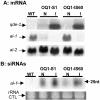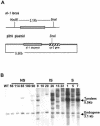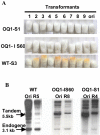The RNA-dependent RNA polymerase, QDE-1, is a rate-limiting factor in post-transcriptional gene silencing in Neurospora crassa
- PMID: 15090622
- PMCID: PMC407816
- DOI: 10.1093/nar/gkh530
The RNA-dependent RNA polymerase, QDE-1, is a rate-limiting factor in post-transcriptional gene silencing in Neurospora crassa
Abstract
The RNA-dependent RNA polymerase (RdRP) qde-1 is an essential component of post-transcriptional gene silencing (PTGS), termed 'quelling' in the fungus Neurospora crassa. Here we show that the overexpression of QDE-1 results in a dramatic increase in the efficiency of quelling, with a concomitant net increase in the quantity of al-1 siRNAs. Moreover, in overexpressed strains there is a significant reduction in the number of transgenes required to induce quelling, and an increase in the phenotypic stability despite progressive loss of tandemly repeated transgenes, which normally determines reversion of a silenced phenotype to wild type. These data suggest that the activation and maintenance of silencing in Neurospora appear to rely both on the cellular amount of QDE-1 and the amount of transgenic copies producing RNA molecules that act as a substrate for the RdRP, implicating QDE-1 as a rate-limiting factor in PTGS.
Figures





Similar articles
-
Gene silencing in Neurospora crassa requires a protein homologous to RNA-dependent RNA polymerase.Nature. 1999 May 13;399(6732):166-9. doi: 10.1038/20215. Nature. 1999. PMID: 10335848
-
Isolation of quelling-defective (qde) mutants impaired in posttranscriptional transgene-induced gene silencing in Neurospora crassa.Proc Natl Acad Sci U S A. 1997 Sep 16;94(19):10233-8. doi: 10.1073/pnas.94.19.10233. Proc Natl Acad Sci U S A. 1997. PMID: 9294193 Free PMC article.
-
The RNA-dependent RNA polymerase essential for post-transcriptional gene silencing in Neurospora crassa interacts with replication protein A.Nucleic Acids Res. 2008 Feb;36(2):532-8. doi: 10.1093/nar/gkm1071. Epub 2007 Nov 29. Nucleic Acids Res. 2008. PMID: 18048414 Free PMC article.
-
Quelling in Neurospora crassa.Adv Genet. 2002;46:277-303. doi: 10.1016/s0065-2660(02)46010-5. Adv Genet. 2002. PMID: 11931228 Review. No abstract available.
-
Quelling: post-transcriptional gene silencing guided by small RNAs in Neurospora crassa.Curr Opin Microbiol. 2007 Apr;10(2):199-203. doi: 10.1016/j.mib.2007.03.016. Epub 2007 Mar 28. Curr Opin Microbiol. 2007. PMID: 17395524 Review.
Cited by
-
Remodeling of perturbed chromatin can initiate de novo transcriptional and post-transcriptional silencing.Proc Natl Acad Sci U S A. 2024 Jul 30;121(31):e2402944121. doi: 10.1073/pnas.2402944121. Epub 2024 Jul 25. Proc Natl Acad Sci U S A. 2024. PMID: 39052837 Free PMC article.
-
Structural insights into the dual activities of the two-barrel RNA polymerase QDE-1.Nucleic Acids Res. 2022 Sep 23;50(17):10169-10186. doi: 10.1093/nar/gkac727. Nucleic Acids Res. 2022. PMID: 36039765 Free PMC article.
-
High throughput genome-wide survey of small RNAs from the parasitic protists Giardia intestinalis and Trichomonas vaginalis.Genome Biol Evol. 2009 Jul 6;1:165-75. doi: 10.1093/gbe/evp017. Genome Biol Evol. 2009. PMID: 20333187 Free PMC article.
-
The frequency and efficiency of endogene suppression by transitive silencing signals is influenced by the length of sequence homology.Plant Physiol. 2006 Oct;142(2):788-96. doi: 10.1104/pp.106.083956. Epub 2006 Aug 4. Plant Physiol. 2006. PMID: 16891552 Free PMC article.
-
Identification of an RNA silencing suppressor from a plant double-stranded RNA virus.J Virol. 2005 Oct;79(20):13018-27. doi: 10.1128/JVI.79.20.13018-13027.2005. J Virol. 2005. PMID: 16189004 Free PMC article.
References
-
- Hammond S.M., Bernstein,E., Beach,D. and Hannon,G.J. (2000) An RNA-directed nuclease mediates post-transcriptional gene silencing in Drosophila cells. Nature, 404, 293–296. - PubMed
-
- Bernstein E., Caudy,A.C., Hammond,S.M. and Hannon,G.J. (2001) Role for a bidentate ribonuclease in the initiation step of RNA interference. Nature, 409, 363–336. - PubMed
-
- Fire A., Xu,S., Montgomery,M.K., Kostas,S.A., Driver,S.E. and Mello,C.C. (1998) Potent and specific genetic interference by double-stranded RNA in Caenorhabditis elegans. Nature, 391, 806–811. - PubMed
Publication types
MeSH terms
Substances
LinkOut - more resources
Full Text Sources
Other Literature Sources
Research Materials

